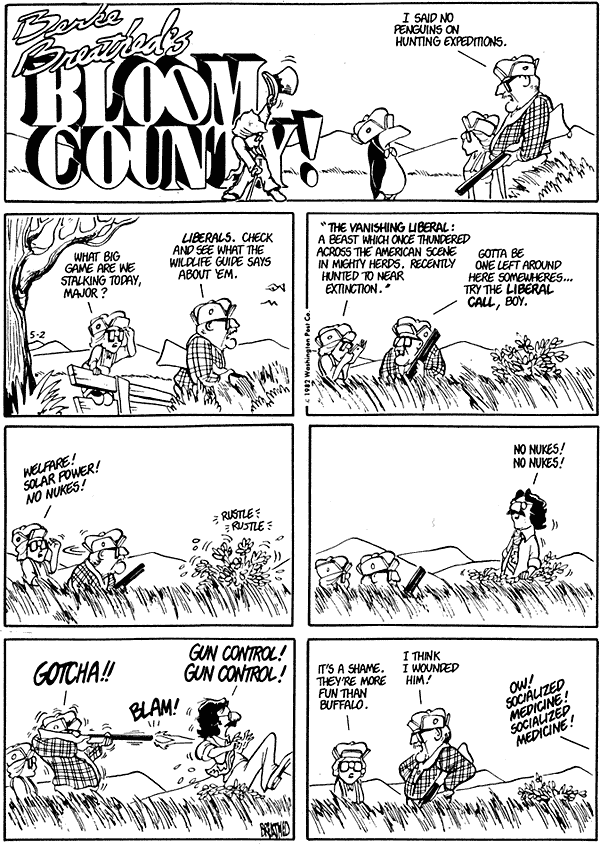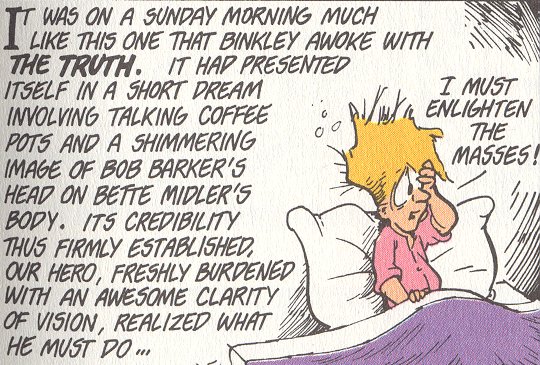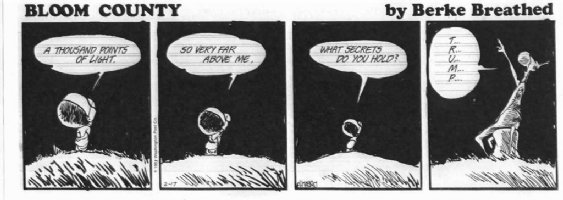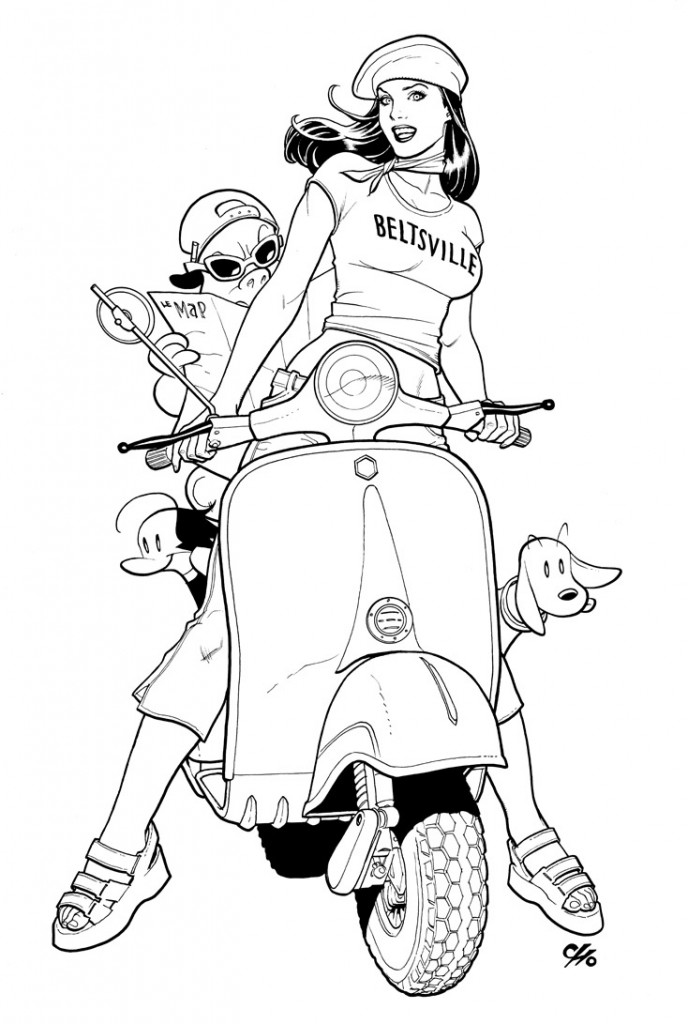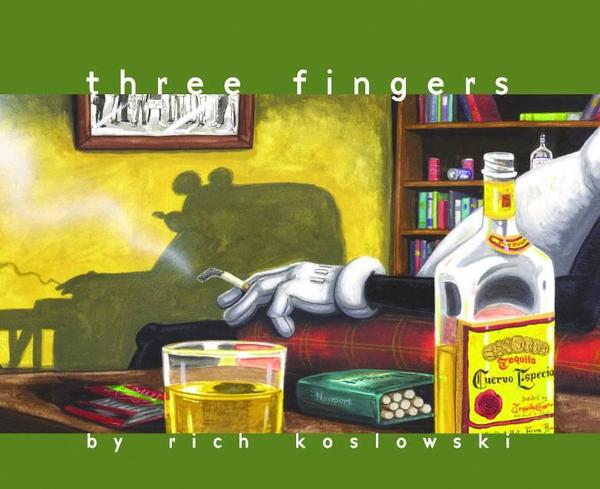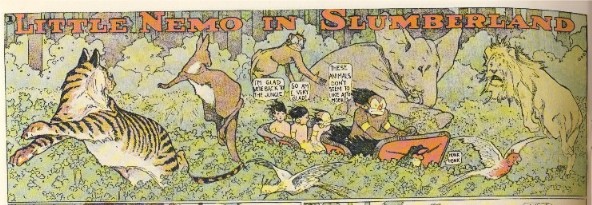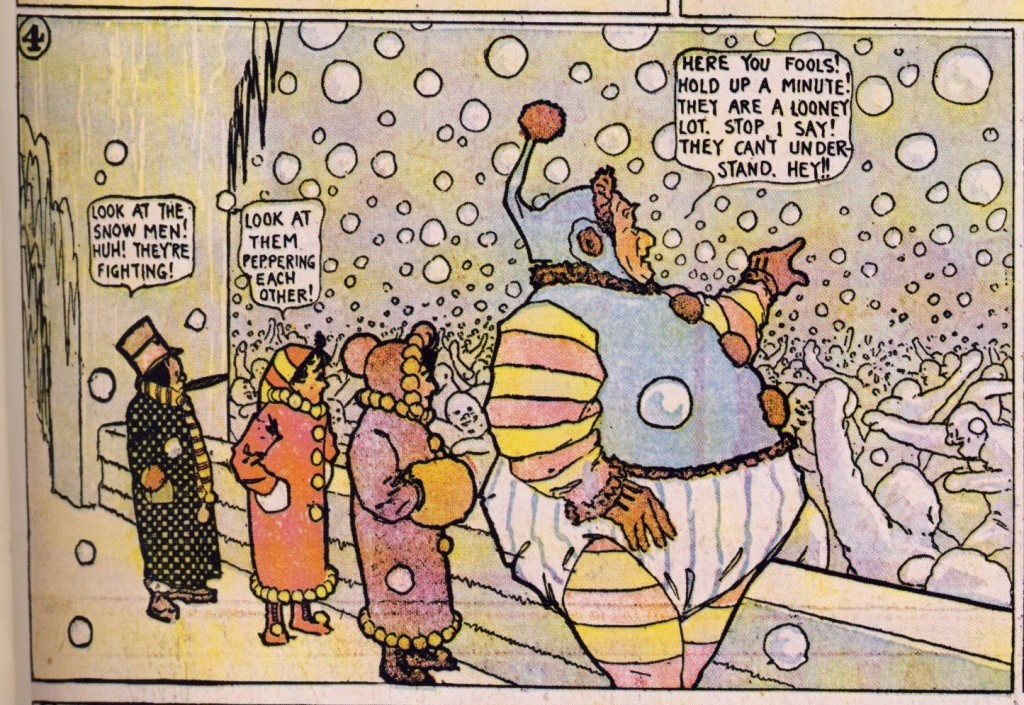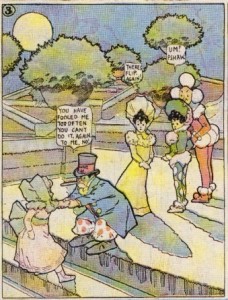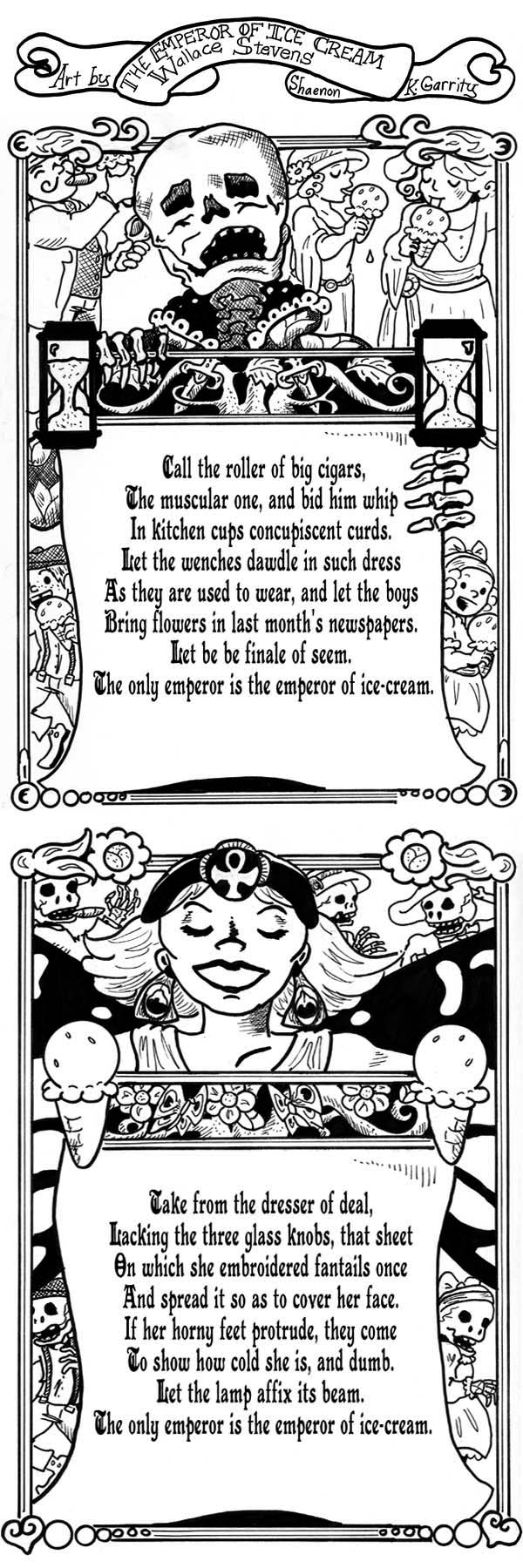As a lady who frequently rants about lady issues, I have been selected by the Hooded Utilitarian to write a piece about lady cartoonists that will somehow not make all ladies reading it roll their eyes and groan. This is my punishment for all the ranting. I’ve learned my lesson.
Eleven years ago, when The Comics Journal put out its big Top 100 Comics by English-Speaking White Men of All Time Ever Except Dave Sim Because Seriously, Fuck That Guy, five women made the list: Lynda Barry, Julie Doucet, Carol Tyler, Debbie Dreschler, and Françoise Mouly for her work as co-editor of RAW. When the preliminary votes for the HU list were being counted up, it looked like only four women would make that list. Interestingly, it was four completely different women, which led me to suggest that maybe this stuff has nothing to do with talent or recognition; the comics industry simply has room for only four or five women at a time.
By the time all the votes had rolled in and the final tally was made, the HU 115 included a grand total of nine ladies. Is that better? Worse? Essentially the same? I don’t know. Mining the list for observations on which to pontificate, I notice that most of the artists are fairly recent—or, in the cases of Tove Jansson and Moto Hagio, new to U.S. audiences. There seems to be little love for classic old-timey creators like Nell Brinkley, Grace Drayton, Gladys Parker, or Marge Buell. No women from the underground era made the list either: no Trina Robbins, Lee Marrs, Dori Seda, Carol Lay, or Shary Flenniken, whose Trots and Bonnie is currently poised to take over as the Family Feud #1 answer to “Inexplicably Unavailable in a Sweet Reprint Edition” the moment someone finally does a Barnaby book. Autobio pioneer Carol Tyler, one of the four women on TCJ’s list, didn’t make the HU list, despite recently emerging from semi-retirement with the new graphic novel series You’ll Never Know.
On the opposite end of the spectrum, very recent cartoonists were, understandably, also left out; if my brief skim of the list is accurate, the HU 115 includes no webcomics. I can imagine a future list making room for works by Dylan Meconis, Spike Trotman, Jenn Manley Lee, Jess Fink, Dorothy Gambrell, Kate Beaton (of course), and other webcartoonists.
And Carla Speed McNeil. And Lea Hernandez. And Gail Simone. And Fumi Yoshinaga. And Jill Thompson. And Jessica Abel. And Wendy Pini. And Riyoko Ikeda. And Colleen Doran. And Vera Brosgol and Jen Wang and I am going to have to stop before I get in trouble for everyone I’m leaving off.
Alison Bechdel, Fun Home and Dykes to Watch Out For
Eleven years ago, when TCJ’s 100 Comics of the Century came out, I thought Alison Bechdel’s alt-weekly strip Dykes to Watch Out For, one of my favorite comics, was a glaring omission. But then I checked myself. If it didn’t get voted in, I thought, doubtless there was a good reason. It probably wasn’t as good as I thought it was. I just identified too closely with the cast of neurotic, intellectual, painfully liberal East Coast lesbians. I wasn’t a lesbian, but I was a Vassar student, which was about the same thing. At any rate, I figured the guys making the TCJ list knew what they were talking about, and Dykes to Watch Out For was just okay.
Now that I’m older, I realize this was bullshit, comics fans just have terrible taste, and Alison Bechdel had to write a big fat supergenius graphic novel with layered references to Proust and Joyce to get the comics world to realize what an amazing talent she is.
If the HU list is any indication, the critical success of Fun Home has inspired critics to take a second look at Dykes to Watch Out For, which followed its ever-expanding cast for 25 years of hookups, breakups, marriages, kids, desperate efforts to keep Madwimmin Books running, and eye-popping political freakouts. It’s like a For Better or for Worse that never went all weird at the end, and also ranted at you about the Bush administration. It’s also an inspiring work to read from beginning to end, just to see how good Bechdel’s art eventually gets.
Marjane Satrapi, Persepolis
First published in France in 2000, then translated into English as the U.S. mired itself in two Mideast wars like a giant sloth lumbering into a tar pit, Marjane Satrapi’s autobiography Persepolis hit the zeitgeist where it hurt. Satrapi’s experiences as a girl growing up in a family of intellectuals in post-revolutionary Iran, then as a drifting expat in Europe, were the perfect surface upon which literary critics and political pundits alike could project their ideas about the Mideast. There was the wildly excited reception Persepolis enjoyed, in the mainstream media as well as the comics press, when it first appeared in English. Then, when the praise tipped over the top, the inevitable anti-Persepolis backlash. Then a second wind of support when the movie adaptation came out, support that lasted long enough to win the film an Oscar nomination for Best Animated Feature. (It lost to Ratatouille.)
Persepolis is above all a story of contrasts: East and West, ancient and modern, religious and secular, girl and woman, its title describing both the ancient seat of learning and culture and the city where uniformed thugs harass women on the street. Even the art shows two faces to the world, suggesting either fine Persian miniatures or children’s scribbles depending on which reviews you read. It’s a cleverly constructed puzzle box of a narrative, saved from pretentiousness by Satrapi’s fiery storytelling and irreverent sense of humor. Satrapi has gone on to draw more comics inspired by her Iranian upbringing — my favorite is the 2005 graphic novella Embroideries — but none has matched the cultural one-two punch of Persepolis.
Julie Doucet, the Dirty Plotte stories, including My New York Diary
Of all the countless autobiographical indie zinesters of the late 1980s and 1990s, Julie Doucet has best survived the test of time. Is it her big, swaggering art style? Her unique French-Canadian-punk-in-New-York perspective? Her willingness to get gruesomely confessional in stories brimming with sex, shit, and menstrual blood? Or is it just that she left her audience wanting more? After her series Dirty Plotte and the collection My New York Diary, Doucet stopped drawing comics. In interviews at the time, she expressed dissatisfaction with the comics world, interest in being taken seriously as a fine artist, and good old-fashioned lack of money.
Since then, Doucet has focused on fine art and on mixed-media projects like Long Time Relationship and 365 Days: A Diary, projects that employ elements of comic art but skirt the standard definition of “comic book.” The Dirty Plotte stories survive as a snapshot of this particular woman, in that particular time, gleefully kicking down the walls of an art form. Dirty Plotte is as perfect an encapsulation of the ’90s as Peter Bagge’s Hate, but coming from a messier, bloodier, hairier place. Yeah, that place.
Natsuki Takaya, Fruits Basket
By far the most popular shojo manga in the U.S., Fruits Basket almost singlehandedly powered Tokyopop for years, routinely trouncing Viz’s shonen juggernauts Naruto and Bleach on the bestseller lists. And yet it’s such a strange manga. Obviously indebted to Rumiko Takahashi, Natsuki Takaya opens her series with a premise reminiscent of Takahashi’s Ranma 1/2: when members of the cursed Sohma family are hugged by someone of the opposite sex, they transform into animals of the Chinese zodiac. Plucky heroine Tohru learns the Sohmas’ secret and moves in with them, inevitably developing romantic connections with the male members—particularly Kyo, the cat, whose patron animal, according to Chinese folklore, was tricked out of his proper place in the zodiac.
It all sounds like the setup for slapstick romantic comedy, but Fruits Basket develops in an entirely different direction, blossoming into a pensive drama about family battles and emotional scars. The supernatural element moves to the background, becoming less a plot point than a symbol of the unresolved tensions haunting the Sohma household. Takaya’s bright, wide-eyed art is like a ray of sunshine into the surprisingly gloomy corners of the story, reflecting the heroine’s upbeat determination to gather her friends to her breast and squeeze out the darkness.
Rumiko Takahashi, Maison Ikkoku
In Japanese comics, men usually draw boys’ manga and women usually draw girls’ manga, but there are exceptions, and superstar manga-ka Rumiko Takahashi — at one time rumored to be the wealthiest woman in Japan outside the royal family — is the exception that shatters all rules. Takahashi first hit it big by inventing the magical-girlfriend sex comedy with her cheeky 1980s series Urusei Yatsura, sadly out of print in English for over a decade, but she makes the HU list for her second manga, Maison Ikkoku, a gentle romantic comedy that originally ran in the not-so-gentle men’s manga magazine Big Comic Spirits.
Maison Ikkoku is less about love than it is about growing up. Hapless hero Godai begins the series as a student “ronin” whose efforts to cram for his college entrance exams are constantly interrupted by his wacky boarding-house neighbors and his crush on the kindly but distant landlady, Kyoko. As we learn more about Kyoko’s sorrows and Godai’s dreams, we realize that, between the comedy hijinks, we’re watching two young people slowly, awkwardly building the paths that will take them into adulthood. After fifteen volumes of romantic complications, sitcom misunderstandings, soap-opera plot twists, and dogs, it’s disarmingly touching when those two paths merge and continue into the future. If this all sounds too touchy-feely, Takahashi is also one of the world’s best illustrators of cute kids and sexy girls, and her art is at its peak in this series, more confident and polished than Urusei Yatsura but lacking the machine-like, assistant-heavy gloss of recent manga like Inuyasha.
Sure, it’s a formula romance. You know how hard it is to write a good romance? I am not ashamed to admit that I cry at least three times every time I read the final volume: at Godai’s “The woman I love” page, when Godai proposes while carrying Kyoko’s father on his back, and the last page, where life at Maison Ikkoku comes full circle.
Lynda Barry, Ernie Pook’s Comeek & the RAW stories
Remember when the “Masters of American Comics” show came out, and some cranky feminists like me complained that there were no women among the Masters, and other people responded with, “Well, what women would you dare put alongside like likes of Jack Kirby, Will Eisner, and the Hernandez Brothers?”
I’m coming out and saying it here: I’d have dumped one of the modern-day Masters to make room for Lynda Barry. In American comics she comes second only to Charles Schulz, the same way Moto Hagio comes second only to Tezuka. Barry’s simple (but deceptively appealing and well-composed) artwork is the perfect vehicle for her harrowing four-panel reports from the bowels of childhood. Seldom have imagos and logos been so perfectly paired, and never has a cartoonist so perfectly captured the voices of her awkward, bespectacled, scribble-haired characters.
In college I didn’t know there were book collections of Ernie Pook, so I used to photocopy the strips out of back issues of the Village Voice in the campus library and make my own. Some of those strips have never been reprinted, so it turned out to be worth it. And few lines from comics have stuck in my head as persistently as lines from Ernie Pook. A single caption from “The Night We All Got Sick” — My land which was gorgeous and smelled like perfume from France — has haunted my skull for ten years.
Moto Hagio, A Drunken Dream and Other Stories
The short-story collection A Drunken Dream isn’t Moto Hagio’s best work, but it’s the only work currently in print in English, so it’ll have to serve as a placeholder for untranslated series like The Heart of Thomas, Marginal, and Otherworld Barbara. A Drunken Dream does provide a nice overview of Hagio’s career, showcasing her development from a conventional 1960s-style artist of cute little girls and flowers into a creator of experimental, psychological fantasies drawn in a delicate but powerfully assured hand.
Hagio, sometimes called the Osamu Tezuka of shojo manga, is the most celebrated member of the extremely celebrated Year 24 Group, a loose collection of brilliant young women who reshaped girls’ manga in the 1970s. Hagio and her then-roommate Keiko Takemiya (who, together, invented the “Boys’ Love” genre with their respective manga The Heart of Thomas and Song of the Wind and Trees) hosted drawing sessions for shojo artists at their apartment, the “Oizumi Salon.” Was Hagio the most gifted of the group? Probably. Not definitely, but probably.
My own introduction to Hagio was through the sadly out-of-print Viz translation of A,A’, one of the first manga I ever read. I’ve spent the past decade immersed in manga — working as a manga editor, writing manga reviews, accumulating piles of stuff about Gundam — largely in the hopes of finding something as good as A,A’. It doesn’t happen often.
Tove Jansson, Moomin
Tove Jansson is best known as a writer and illustrator of children’s books, particularly the internationally beloved Moomin series, but Drawn & Quarterly’s swanky reprints of the Moomin comic strip, which ran in newspapers through a British syndicate for 20 years, have inspired a reassessment of her work as a cartoonist. And it’s worth reassessing: the most successful Finnish comic strip is also one of the smartest, most inventive, and most charming strips ever drawn.
The Moomin characters move through a world that’s both whimsical and hauntingly melancholy. As depicted in the comic strip, it’s also a visual feast, every panel packed with weird flora and fauna. In a touch I can’t recall seeing in any other four-panel strip, Jansson likes to build panel borders out of symbolically relevant objects: knives and forks for a cooking scene, twigs for the outdoors. The plots have the simple profundity of good children’s literature, often revolving around wistful searches for love or identity, and the sequence in which the Moomintroll family sets up a home in a lonely lighthouse strikes me as one of the most beautiful stories I’ve read in a comic. But I always wanted to be a lighthouse keeper.
Pia Guerra (with Brian K. Vaughan), Y: The Last Man
The first sci-fi stories about all-female societies were men’s fantasies: either dystopias where women turned the world into an oversized ant nest or something equally horrific, or else cheesy setups for one-handed Earthman-teach-us-this-thing-called-kissing scenarios. The next batch, in the 1970s, were women’s fantasies: enlightened and rugged lesbian co-ops bristling with sisterhood, like the settings of Joanna Russ’s “When It Changed” and James Tiptree, Jr.’s “Houston, Houston, Do You Read?” (a title that gets name-checked in the first issue of Y: The Last Man).
By the time of Y: The Last Man, arguably the best Vertigo comic of the last ten years, the question of women’s place in society had moved beyond fantasies, beyond ideologies, and into practical concerns. Y is an action story, a story of survival. It’s postfeminism as pulp. And it wouldn’t work without Pia Guerra’s tough, earthy art. Guerra’s work has a classic comic-book action gloss, but with an unusual attention to detail and gift for drawing faces and expressions. She captures both the pulpiness and the human element of Brian K. Vaughan’s story. It’s almost too tidy that the third wave of world-of-women fiction should be represented by the collaboration of a male writer and a female artist, but truth is less subtly written than fiction.
Best Comics Poll Index
